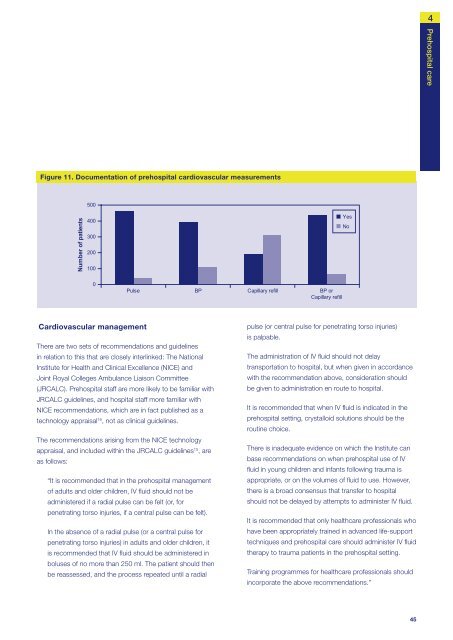NCEPOD: Trauma - Who Cares? - London Health Programmes
NCEPOD: Trauma - Who Cares? - London Health Programmes
NCEPOD: Trauma - Who Cares? - London Health Programmes
You also want an ePaper? Increase the reach of your titles
YUMPU automatically turns print PDFs into web optimized ePapers that Google loves.
4Prehospital careFigure 11. Documentation of prehospital cardiovascular measurements500Number of patients400300200100YesNo0Pulse BP Capillary refill BP orCapillary refillCardiovascular managementThere are two sets of recommendations and guidelinesin relation to this that are closely interlinked: The NationalInstitute for <strong>Health</strong> and Clinical Excellence (NICE) andJoint Royal Colleges Ambulance Liaison Committee(JRCALC). Prehospital staff are more likely to be familiar withJRCALC guidelines, and hospital staff more familiar withNICE recommendations, which are in fact published as atechnology appraisal 16 , not as clinical guidelines.The recommendations arising from the NICE technologyappraisal, and included within the JRCALC guidelines 15 , areas follows:“It is recommended that in the prehospital managementof adults and older children, IV fl uid should not beadministered if a radial pulse can be felt (or, forpenetrating torso injuries, if a central pulse can be felt).In the absence of a radial pulse (or a central pulse forpenetrating torso injuries) in adults and older children, itis recommended that IV fl uid should be administered inboluses of no more than 250 ml. The patient should thenbe reassessed, and the process repeated until a radialpulse (or central pulse for penetrating torso injuries)is palpable.The administration of IV fl uid should not delaytransportation to hospital, but when given in accordancewith the recommendation above, consideration shouldbe given to administration en route to hospital.It is recommended that when IV fl uid is indicated in theprehospital setting, crystalloid solutions should be theroutine choice.There is inadequate evidence on which the Institute canbase recommendations on when prehospital use of IVfl uid in young children and infants following trauma isappropriate, or on the volumes of fl uid to use. However,there is a broad consensus that transfer to hospitalshould not be delayed by attempts to administer IV fl uid.It is recommended that only healthcare professionals whohave been appropriately trained in advanced life-supporttechniques and prehospital care should administer IV fl uidtherapy to trauma patients in the prehospital setting.Training programmes for healthcare professionals shouldincorporate the above recommendations.”45
















